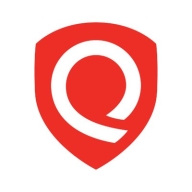

Qualys Web Application Scanning and OpenText Core Application Security are key competitors in application security. Qualys is seen as more cost-effective, while OpenText is valued for its advanced capabilities, justifying its higher price point.
Features: Qualys Web Application Scanning offers protection against zero-day vulnerabilities, ease of integration with cloud-based deployment, and provides comprehensive reporting. It facilitates seamless integration in CI/CD pipelines. OpenText Core Application Security stands out for its source code and dynamic scanning, effective vulnerability management, and support for numerous programming languages, which benefits DevOps processes.
Room for Improvement: For Qualys, users suggest enhancements in reducing false positives and improving the user interface design. More mature API integration and pricing adjustments could also be beneficial. OpenText Core Application Security could reduce false positives and streamline its user interface while also improving integration with CI/CD pipelines and enhancing report formats.
Ease of Deployment and Customer Service: Qualys provides flexible cloud deployment options, including hybrid and public cloud settings, with generally positive technical support albeit varying responsiveness. OpenText is mainly deployed on-premises with public cloud options, and user feedback on customer service is mixed, indicating a need for more responsive support.
Pricing and ROI: Qualys is noted for offering competitive licensing with scalability, though some view it as expensive. It has a favorable ROI due to scalable integration and operational savings. OpenText, while pricier, is appreciated for robust features and smooth integration. Its subscription model is scalable but could use more pricing flexibility.
| Product | Market Share (%) |
|---|---|
| OpenText Core Application Security | 3.6% |
| Qualys Web Application Scanning | 2.0% |
| Other | 94.4% |


| Company Size | Count |
|---|---|
| Small Business | 16 |
| Midsize Enterprise | 8 |
| Large Enterprise | 43 |
| Company Size | Count |
|---|---|
| Small Business | 8 |
| Midsize Enterprise | 6 |
| Large Enterprise | 27 |
OpenText Core Application Security offers robust features like static and dynamic scanning, real-time vulnerability tracking, and seamless integration with development platforms, designed to enhance code security and reduce operational costs.
OpenText Core Application Security is a cloud-based, on-demand service providing accurate and deep scanning capabilities with detailed reporting. Its integrations with development platforms ensure an enhanced security layer in the development lifecycle, benefiting users by lowering operational costs and facilitating efficient remediation. The platform addresses needs for intuitive interfaces, API support, and comprehensive vulnerability assessments, helping improve code security and accelerate time-to-market. Despite its strengths, challenges exist around false positives, report clarity, and language support, alongside confusing pricing and package options. Enhancements are sought in areas like CI/CD pipeline configuration, report visualization, scan times, and integration with third-party tools such as GitLab, container scanning, and software composition analysis.
What features define OpenText Core Application Security?Industries like mobile applications, e-commerce, and banking leverage OpenText Core Application Security for its ability to identify vulnerabilities such as SQL injections. Integrating seamlessly with DevSecOps and security auditing processes, this tool supports developers in writing safer code, ensuring secure application deployment and enhancing software assurance.
Qualys Web Application Scanning (WAS) is a fully cloud-based web application security scanner. The scanner will automatically crawl periodically and test web applications to discover potential vulnerabilities, including cross-site scripting (XSS) and SQL injection. The consistent testing equips the automated service to generate consistent results, lessen false positives, and offer the ability to scale to protect thousands of websites effortlessly.
Qualys Web Application Scanning is bundled with different scanning technology to carefully scan websites for malware infections and will send notifications to website owners to assist in preventing blacklisting and brand reputation damage. As digital transformation takes place in various organizations, Qualys WAS gives organizations the ability to track and document their web app security status through its interactive reporting capabilities.
Qualys WAS empowers organizations to remediate any web application vulnerabilities quickly. Some of the key tools offered are:
Benefits of Qualys Web Application Scanning
Qualys Web Application Scanning offers many benefits, including:
Reviews from Real Users
Qualys Web Application Scanning stands out among its competitors for a variety of reasons. Two of those reasons are its progressive scan and quick detection of vulnerabilities.
P.K., a senior software developer at a tech vendor, writes, "The feature that I have found most valuable is the progressive scan. It is good. It's done in 24 hours."
Nagaraj S., lead cybersecurity engineer at a tech service company, notes, "I have found the detection of vulnerabilities tool thorough with good results and the graphical display output to be wonderful and full of colors. It allows many types of outputs, such as bar and chart previews."
We monitor all Application Security Tools reviews to prevent fraudulent reviews and keep review quality high. We do not post reviews by company employees or direct competitors. We validate each review for authenticity via cross-reference with LinkedIn, and personal follow-up with the reviewer when necessary.